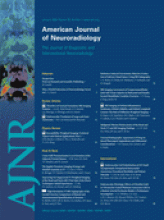Abstract
BACKGROUND AND PURPOSE: The purpose of this study was to assess how well the anatomy of the jugular foramen (JF) could be displayed by 3T MR imaging by using a 3D contrast-enhanced fast imaging employing steady-state acquisition sequence (CE-FIESTA) and a 3D contrast-enhanced MR angiographic sequence (CE-MRA).
MATERIALS AND METHODS: Twenty-five patients free of skull base lesions were imaged on a 3T MR imaging scanner using CE-FIESTA and CE-MRA. Two readers analyzed the images in collaboration, with the following objectives: 1) to score the success with which these sequences depicted the glossopharyngeal (CNIX) and vagus (CNX) nerves, their ganglia, and the spinal root of the accessory nerve (spCNXI) within the JF, and 2) to determine the value of anatomic landmarks for the in vivo identification of these structures.
RESULTS: CE-FIESTA and CE-MRA displayed CNIX in 90% and 100% of cases, respectively, CNX in 94% and 100%, and spCNXI in 51% and 0% of cases. The superior ganglion of CNIX was discernible in 89.8% and 87.8%; the inferior ganglion of CNIX, in 73% and 100%; and the superior ganglion of CNX, in 98% and 100% of cases. Landmarks useful for identifying these structures were the inferior petrosal sinus and the external opening of the cochlear aqueduct.
CONCLUSIONS: This study protocol is excellent for displaying the complex anatomy of the JF and related structures. It is expected to aid in detecting small pathologies affecting the JF and in planning the best surgical approach to lesions affecting the JF.
- Copyright © American Society of Neuroradiology












